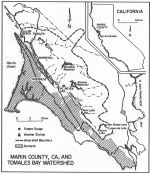Biogeochemical Reactions in Estuaries (BRIE)
TOMALES BAY, which lies about 50 kilometers (kin) northwest of San Francisco in a rift valley formed by the San Andreas Fault, has been chosen as a site to study whole-system land-estuary- ocean exchanges and net biogeochemical reactions. Materials of primary interest are the nutrient elements carbon (C), nitrogen (N), and phosphorus (P). The linear shape of the Bay (20 km long by 1.4 km wide), its well-defined freshwater inflow, and simple water exchange are readily described with a one- dimensional circulation model. Water exchange is slow during most of the year, and net chemical reactions in the Bay alter water composition substantially.
Despite the simple hydrologic and hydrographic regimes of this system, biotic community structure and biogeochemical function appear typical of North American Pacific Coast estuaries.
Site Characteristics
Despite its proximity to a large urban area, the 560km2 Tomales Bay watershed has a population density of only about 20 persons/km2. Unlike many North American estuaries, water discharge to Tomales Bay has not been greatly disrupted by human intervention. The Bay receives low input of dissolved pollutants. Fishing pressure on the system is also low. The major human perturbation which has affected this system is that replacement of native vegetation by introduced grasses and extensive grazing have apparently increased sediment discharge to the Bay.
Marine research in Tomales Bay dates back to the late 1940’s, when the Pacific Marine Station was built near the mouth of the Bay. With the closing of that laboratory in 1979, study of the Bay decreased. Then in 1985, cooperative research efforts by San Francisco State University, the U.S. Geological Survey, and the University of Hawaii rekindled scientific interest. In 1987-88, a one-year NSF-funded study of the nutrient dynamics over an annual cycle was begun. That study was extended through a second year, on the assumption that a two-year drought would break and alter the input of terrigenous materials.
It became increasingly apparent that Tomales Bay was ideally suited for long-term studies of responses of an estuarine ecosystem to material exchanges with the land and ocean. The BRIE-LMER program was funded in October 1989 and has provided continuation of the bimonthly analysis extending back to June 1987.
Approach and Methodology
BRIE-LMER research on the Tomales Bay ecosystem can be divided into seven major components:
- Analysis of nonconservative fluxes of the nutrient elements C, N, and P, based on hydrographic surveys and material budgets
- Sedimentation analysis, both from radiometric age dating of cores and from estimating suspended load delivery by streams
- Analysis of circulation and the effects of coastal upwelling, based on physical oceanographic studies
- C, N, and P cycling through major biotic components of the ecosystem, from field and laboratory experimentation
- Evaluation of sites and controls of nitrogen fixation and denitrification, based on field and laboratory experimentation
- Modeling of terrigenous and marine contributions to nutrient fluxes
- Ecosystem modeling of biogeochemical C, N, and P cycling, and the controls on that cycling
Preliminary Results:
Dissolved nutrient concentrations in the Bay appear more strongly related to regeneration from particulate material than to dissolved nutrient delivery. The system exports more dissolved P than it imports, while dissolved N import exceeds export. The interpretation being tested with smaller-scale experiments is that net organic oxidation releases dissolved P, while net denitrification consumes dissolved N. If this interpretation is correct, then there must be some external source of particulate organic matter supporting these fluxes. Two processes seem to account for most particulate organic delivery: runoff and tidal input of the products of coastal upwelling.
Rainfall and runoff are almost entirely confined to the months November-April. Rainfall records at one site date back to 1876. That period shows strong inter- annual variations and long-term trends in rainfall. The bay-wide sedimentation rate between 1850 and 1950 was approximately 8 millimeters/year, based on mapped changes in bay water depth. Most sedimentation is apparently associated with land-derived input, with little sediment escape to coastal ocean.
Coastal upwelling occurs along much of the Pacific Coast in response to periods of strong, persistent northwesterly winds. While such conditions can occur anytime during the year, they occur most frequently April through September. There is more than a twofold interannual variation in upwelling intensity, with the period of study showing about average conditions in comparison to about 45 years of data. Coastal upwelling elevates dissolved nutrient concentrations at the Bay mouth. However, the major effect of this upwelling is probably related to particulate, rather than dissolved, fluxes. Presumably, primary production of the coastal ocean is enhanced by elevated nutrients, leading to the delivery of increased particulate organic detritus to
the Bay.
Biogeochemical reactions in this system are affected by variable inputs from adjacent terrestrial and marine environments. Lessons learned about ecosystem responses to variable inputs in relatively small, tractable ecosystems like Tomales Bay can be extended to larger and more complex ecosystems.
For more information, contact J. T. Hollibaugh, Tiburon Center, San Francisco State University, P.O. Box 855, Tiburon CA 94920; or S. V. Smith, Department of Oceanography, University of Hawaii Honolulu HI 96822.

 Enlarge this image
Enlarge this image